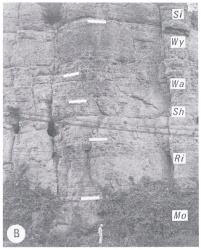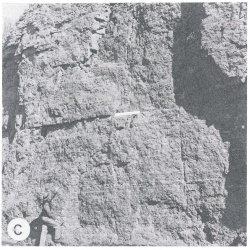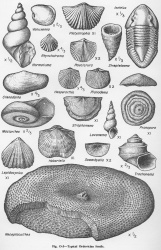Wise Lake Formation
Lithostratigraphy: Ottawa Limestone Megagroup >>Galena Group >>Kimmswick Subgroup >>Wise Lake Formation
Chronostratigraphy: Paleozoic Erathem >>Ordovician System >>Champlainian Series >>Trentonian Stage
Allostratigraphy: Tippecanoe Sequence
Primary source
Willman, H. B., Elwood Atherton, T. C. Buschbach, Charles Collinson, John C. Frye, M. E. Hopkins, Jerry A. Lineback, and Jack A. Simon, 1975, Handbook of Illinois Stratigraphy: Illinois State Geological Survey Bulletin 95, 261 p.
Contributing author(s)
H. B. Willman and T. C. Buschbach
Name
Original description
Wise Lake Formation (Templeton and Willman, 1963, p. 125).
Derivation
The Wise Lake Formation is named for Wise Lake, a lake on the Mississippi River floodplain near the type section.
Other names
History/background
Type section
Type location
The type section of the Wise Lake Formation is at the north end of a prominent bluff, 6 miles south of Galena, Jo Daviess County (cen. NE 21, 27N-1E), where the formation is 70.9 feet thick.
Type author(s)
Type status
Reference section
Reference location
Reference author(s)
Reference status
Stratigraphic relationships
Extent and thickness
The Wise Lake Formation, persistently 67-75 feet thick, occurs throughout the northern outcrop area (fig. O-2B, C) and southward in subsurface to the central part of the state, where it is sharply truncated by Cincinnatian strata.
Lithology
The Wise Lake Formation consists of relatively pure dolomite and limestone overlying the cherty Dunleith Formation and underlying the shaly Dubuque Formation. The Wise Lake consists of noncherty, medium- to thick-bedded, vuggy, pure dolomite in the northern outcrop area. The southern limestone facies is not exposed in Illinois, but in outcrops near New London, in Ralls County, Missouri, it is thick-bedded, fine-grained, to lithographic, pure limestone. The Wise Lake is subdivided into two members; the basal Sinsinawa Member is thinner bedded and slightly less pure than the Stewartville above it. The Wise Lake Formation is the purest of the carbonate formations in the Galena Group and is equivalent and lithologically similar to relatively pure formations throughout much of the continent.
Core(s)
Photograph(s)
Contacts
Well log characteristics
Fossils
Receptaculites oweni (fig. O-5) is abundant and persistently present in the lower 10-15 feet of the Stewartville Member of the Wise Lake Formation, called the Upper Receptaculites Zone, and is associated with a gastropod-cephalopod fauna. Maclurites cuneata and Hormatoma major (fig. O-5) are common in some localities. The Sinsinawa Member of the Wise Lake Formation is less fossiliferous but contains gastropods and, in places, a few Receptaculites.
Age and correlation
The Wise Lake Formation consists of strata formerly included in the Stewartville Formation and in the upper part of the Prosser Formation in the Upper Mississippi Valley. It is equivalent to the Steuben Member of the Cobourg Limestone in New York and Ontario, the upper part of the Lexington Limestone in Kentucky, and the upper part of the Bigby-Cannon Formation in Tennessee.
Environments of deposition
The Wise Lake is thought to represent the greatest submergence of the continent during Paleozoic time.
Economic importance
Remarks
References
TEMPLETON, J. S., and H. B. WILLMAN, 1963, Champlainian Series (Middle Ordovician) in Illinois: Illinois State Geological Survey Bulletin 89, 260 p.
ISGS Codes
| Stratigraphic Code | Geo Unit Designation |
|---|---|


